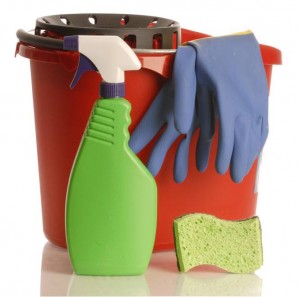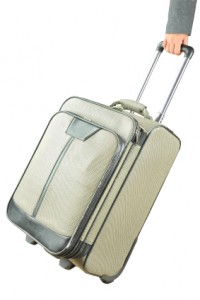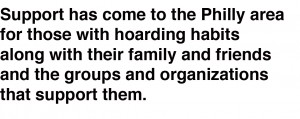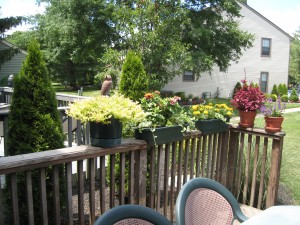 I don’t know about you, but spring is my favorite time of year, and the last thing I want to do is spend my weekend or multiple weekends focusing on cleaning and organizing my entire home. Instead of pulling out that long list of spring cleaning duties, consider breaking up the list into bite size pieces to be completed throughout the year.
I don’t know about you, but spring is my favorite time of year, and the last thing I want to do is spend my weekend or multiple weekends focusing on cleaning and organizing my entire home. Instead of pulling out that long list of spring cleaning duties, consider breaking up the list into bite size pieces to be completed throughout the year.
Maintenance is a much easier solution and a tremendous time saver.
Pick Your Battles
Look at your list and determine the cleaning and organizing tasks that make the most sense for this time of year. For example, closets are a great place to start because this is the time of year we change from winter to spring/summer attire. Garages are another good area of focus. Now is the time to put away the snow blower and pull out the lawn mower. And, let’s be honest, things tend to get piled and tossed into the garage all winter, so it’s time for a garage clean-out. Your garden shed is another great fit for seasonal organizing. Inspect and sharpen your garden tools, take stock of your supplies, clean your clay pots and determine your tool storage area based on how often you use the tools. Also, with the onset of warmer weather comes the need to change to lighter blankets and comforters, and once the bed is stripped you can vacuum and turn the mattress to complete the process.
Maintenance is Key
Now that you have decided which areas make sense to organize during the spring season; let’s break the rest of that cleaning and organizing list into manageable tasks to be completed throughout the year. Baseboards, doors, and cobwebs can be dusted and cleaned during the winter when you’re stuck inside during a snowstorm. Lampshades and ceiling fans can be dusted at regular intervals when you dust the rest of your home. Draperies, blinds and carpets can be cleaned in the fall or the end of the summer. Many people have self cleaning ovens that can be cleaned any time of the year, and grease traps and stove filters are easy to replace or clean on an as needed basis.
Consistency is the Name of the Game
Having a consistent, year round routine will help you avoid investing large chunks of time in the spring. Instead, get out and smell the forsythia, spend time with family and friends, or do whatever makes you happier at this wonderful time of year. Organizing and cleaning are necessary for a functional life, so finding ways to spread it out and make it easier in the long run will save you endless hours each season.
When you are at a restaurant, in the car, or headed to the beach, do your children drive you crazy by fighting or by saying that they are bored? I have found several variations of a ‘busy bag/box’ on Pinterest, and decided to create my own. My bags have changed over the years accommodating items that will satiate my 4 year old as well as my 7 year old!
Below are some of my ‘Busy Bag’ ideas:
My Restaurant Bag contains:
When my children were toddlers, I used to pack lots of board books, large Duplo blocks, finger puppets, Crayola dough, laminated play dough mats, stacking cups and Fisher Price plastic animals. For older children, add Legos, playing cards, trivia questions, the game Uno, books, Mad libs, and maze books.
My Car Bag contains everything from my restaurant bag, plus the following:
A fun idea that I started — on a 10 hour trip to Myrtle Beach — was to get baby links from the dollar store and connect them from one car hook to the one across from it in the backseat, and a super hero traveled link to link every hour that passed. Also, since each of my children had a small version of the car bag next to them, with each activity organized inside a smaller container, there were no melt downs!
Taking a family of four to the beach is like a jigsaw puzzle. Everything needs to be organized and in a certain area or else it will be covered in sand or forgotten. Thanks to many invites to Thirty One parties I am well prepared for the beach with bags!
My Beach Bag is a system of smaller bags:
Staying organized, even on vacation, helps to keep my sanity, as well as my husband’s when the ice cream man rings his bell and both children start running towards him. All he has to do is reach in the pouch for the money and not waste any time looking for it. I hope I have inspired you to create your own “Bags” for whatever situation calls for it.
Have fun and safe travels this summer!
 There are a few basic components of your vacation you need to consider before you select certain articles and start to pack. If you are traveling by air, be aware of your carrier’s baggage restrictions. This is the time to be efficient with your space! Below are my 20 tips to help you pack like a pro:
There are a few basic components of your vacation you need to consider before you select certain articles and start to pack. If you are traveling by air, be aware of your carrier’s baggage restrictions. This is the time to be efficient with your space! Below are my 20 tips to help you pack like a pro:
Now zip your suitcase and go! Bon Voyage!

Along with four other Professional Organizers, I had the opportunity to attend a meeting of the Philadelphia Hoarding Task Force and was excited to find out that we are NOT ALONE!
The result of hoarding behaviors touches countless lives. The most obvious is the lives of those with hoarding habits, those who live with them, their children, family members, and close friends. Maybe, less obvious, is the effect of this life style on their surrounding communities. Often times there have been multiple attempts to deal with and support those with hoarding habits resulting in little change and outcomes that don’t last long. Interventions usually focus on having the person divest themselves of things that clutter their living spaces. Frustration, hard feelings are the typical results as little seems to penetrate the multifaceted web of commingled issues, emotions and unrelenting habits that have, more likely than not, spanned the individual’s life time.
This particular and persistent practice of collecting is the manifestation of a complex network of interpretations for the person who engages in hoarding behaviors. For many who are observing these hoarding tendencies, it is virtually impossible to understand, decipher, and make sense of the complexities involved in the condition. Working side by side with clients who engage in hoarding behaviors, I have heard very elaborate and creative explanations for their holding on to what looks like, to anyone else, seemingly useless items. Their ‘need’ to save things is logical in their view, however, the result of their logic is counterproductive to their desire to alleviate their situation that impacts themselves, their loved ones, and in some cases, their community.
Because the result of hoarding behaviors looks like disorganization and clutter, at first glance, it would seem like working with hoarding situations is perfectly suited for the organizing profession. Initially, that was the thinking of the pioneers of our profession until they began to notice that successful organizing methodologies, principles, and products did not seem to work with certain clients. During those early years, organizers tried to impact situations where shower rods became alternate hanging spaces for clothes, dining room tables became storage for piles of papers often flowing over to the accompanying chairs, and beds housed everything else leaving little to no room for the owner. The result, a sub group of NAPO was birthed. Back then it was called NSGCD (The National Study Group on Chronic Disorganization). Today, it is its own independent organization called The Institute for Challenging Disorganization (www.ChallengingDisorganization.org). Their mission is to provide education, research, and strategies to benefit people challenged by chronic disorganization.
Working with these situations for the past 11 years as well as being a member of NAPO and ICD, I have learned that simply talking about the ‘stuff’ with clients is limiting and often times futile. Getting to the reasons and explanations for their need to hold on to items helps to unlock the interpretation that justifies their hoarding behaviors and often times can loosen the grip of their ‘need’ to hold on to things. However, delving into the root cause of these tendencies is outside an organizer’s skill set and training. Teaming up with other professionals such as social workers and therapists, offers more hope for longer-lasting results.
Finding these opportunities to team up with other professionals working with people challenged with chronic disorganization has not been easy until recently when the Greater Philadelphia Chapter of NAPO (NAPO-GPC) was contacted and invited to participate on the Philadelphia Hoarding Task Force. An impressive list of local organizers accepted the invitation, and it was love at first meeting! Finally, we are NOT ALONE in our work with these clients!
Still in its infancy, the mission of the Philadelphia Hoarding Task Force, co-chaired by David Wengert from the Community Legal Services and Katherine Martin, Deputy Policy Director from the Mayor’s office, is to “ensure positive outcomes for those individuals who are impacted by hoarding.” Although the Task Force does not provide direct services, its role is to ensure access to resources, training for provider organizations, and education about hoarding in Greater Philadelphia”. The meeting that I attended with four of my collogues was comprised of representatives from the Philadelphia Police and Fire Department, Licenses & Inspections, Philadelphia Corporation for Aging, and Clutterers Anonymous, to name a few. Each of the representatives brought their unique perspective to the meeting. The shared conclusions was that the work of the Task Force should focus on the individual, not the problem, i.e. the ‘stuff’ and that this perspective should permeate all efforts made by the Task Force, especially in the educational trainings it provides.
A shared understanding of the complexity that leads to hoarding behaviors among the organizations that confront these circumstances, along with sharing resources, expertise, accountabilities, and services, was music to all of our ears!
Finally, we as organizers, can say, we are NOT ALONE in our work with clients who are struggling with habits of hoarding! Collaborating with other professionals helps us offer those challenged by hoarding habits a more holistic service approach, and a hopeful future.
Suggested Resources:
Tulips, lawnmowers, graduations, home sales… these are all signs that spring is here and, with it, new beginnings.
Here in our NAPO-Greater Philadelphia Chapter, we are also looking at new beginnings. May is the month that NAPO starts its new board term. Volunteers who have served the chapter over the past year have either chosen to remain in their positions, continuing to pursue their goals and enhance their knowledge of and through this incredible organization, or to move on to other equally challenging and rewarding positions.
You see, NAPO-GPC is a professional organization comprised of solo entrepreneurs who come together to serve in volunteer positions and create something akin to a very highly efficient corporation. We serve on boards and organize recycling events, we post weekly blogs and maintain a group website, we host quality educational programs and mentor new organizers, we provide speakers for area home shows and volunteers for local charities. We create annual strategic plans and work all year to actually achieve them – and we do! And we do this all for free.
Crazy right? We can’t really have sustainable businesses and still do all of this – can we? Yes, we can. And we do.
Don’t get me wrong; we’re not a bunch of martyrs. There is a method to our madness! “Volunteering” is another way of getting what we want. And, as business-owners, what do we want? – We want to learn new skills specific to our profession. We want to find out about business development techniques & technologies that can help us grow our businesses. We want the time to volunteer in our communities and make a difference. We want networking opportunities that will benefit our careers.
In our businesses, the approximate 80 professional organizers and corporate associate members that make up NAPO-GPC are out there every day in the communities of Greater Philadelphia organizing offices and homes, helping hoarders and families and business men and women to create greater order, peace and prosperity in their lives.
I am very fortunate to be a part of all of this and, as NAPO-GPC President starting my second term, I would like to thank all of the volunteers that make this organization the shining success that it is (from the blog editor who is posting this letter for me to all the members who choose to serve on the Membership, Technology, Marketing or Professional Development teams). Specifically I thank the outgoing board members who have done so much to serve this chapter: Ellen Tozzi, Jackie Mangasarian, Dan Loya, Barbara Siegel and Carla Shipman.
Next, I would like to acknowledge the new Board of Directors that will serve with me and who are already up and running: Vice President, Debbie Lillard; Past-President, Kathy Luskus; Secretary, Naomi Cook; Treasurer, Emily Anderson; Communications & Technology Director, Gabrielle Watters-Smith; Marketing Director, Darla Pompilio; Membership Director, Annie Amoon Richard; and Professional Development Director, Rachel Gambone.
Finally, I am going to take a brazen and shameless moment to claim bragging rights as one of our NAPO-GPC members becomes President-Elect of the National Association of Professional Organizers. Congratulations to our very own Ellen Faye!
I look forward to another year of education, community, achievement and fun with this amazing group of professionals!
 The weather is finally starting to cooperate, and I am in my ‘container garden’ mode- of- thinking. This is the perfect time to talk about outdoor organizing, as I am in the process of gathering all of my gardening essentials (potting soil, pots, gardening gloves, watering can, etc) to plant my flowers.
The weather is finally starting to cooperate, and I am in my ‘container garden’ mode- of- thinking. This is the perfect time to talk about outdoor organizing, as I am in the process of gathering all of my gardening essentials (potting soil, pots, gardening gloves, watering can, etc) to plant my flowers.
Whether you live in an apartment, condo, or single family home, you should organize your outdoor items such as your gardening tools, lawn equipment, and/or outside furniture. Sorting like items together allows you to know what you have, which in turn will help you to know what you may need to purchase, as well as to help you find things more easily.
Below are my three Outdoor Organizing Tips:
Take advantage of this glorious weather to plant. Then, all you’ll need to do is to sit back, relax, and enjoy the longer days of summer. Some of the best parts are being able to barbecue and to watch your flowers and plants grow.